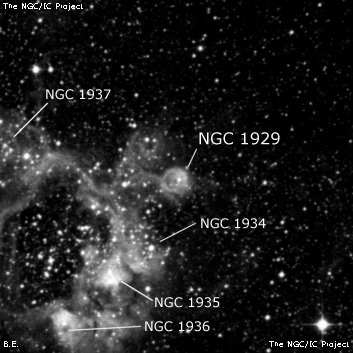
On the DSS this object appears to be a symmetrical bubble. This HII complex and cluster includes the Superbubble complex N44.
John Herschel discovered NGC 1929 = h2840 on 23 Nov 1834 and simply noted "F. The preceding nucleus of the compound nebula figured in fig. 2, Plate III. Place by Delta RA and PD, from the chief nucleus measured on diagram." The sketch clearly established this number refers to the northernmost knot in the complex along the west side.
James Dunlop discovered the LH 47 association = D 175, which contains NGC 1929, on 27 Sep 1826. He described "a pretty large rather faint nebula, about 5' diameter, irregular figure, partly resolvable into stars of mixt magnitudes. The nebulous matter has several seats of attraction, or rather it is a cluster of small nebulae with strong nebulosity common to all." Dunlop's position is roughly 5' SSW of the complex, a good match for Dunlop, and NGC 1929 might be one of the "seats of attraction."
The SIMBAD position is 1.4' too far northeast and does not correspond with a bright knot.
600/800mm - 24" (4/7/08 - Magellan Observatory, Australia): this HII knot is the first in an impressive star cluster/emission complex (stellar association LH 47) that extends over 7' in size and includes NGC 1934, 1935, 1936, 1937, and IC 2126. At 260x it appeared as a bright, moderately large, round glow of ~50" diameter surrounding a 13th magnitude star.
Notes by Steve Gottlieb